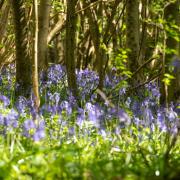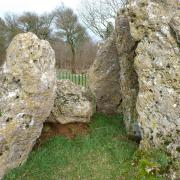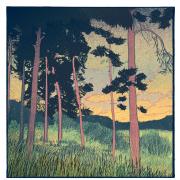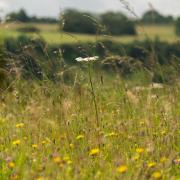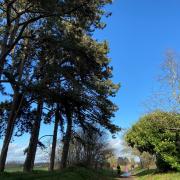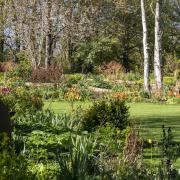There’s plenty of wow factor at Painswick Rococo Garden in winter.
It’s easy to take snowdrops for granted in the Cotswolds. Several gardens have notable displays and many roadside verges are studded with white blooms in winter. Yet, the combination of millions of flowers and quirky garden follies make Painswick Rococo Garden stand out.
The 10-acre garden, laid out in 1740 by Benjamin Hyett, is the country’s sole complete survivor of a flamboyant period of English garden design and, coupled with the winter snowdrops, it’s a dazzling spectacle.
‘It’s the wow factor of seeing the carpet of them,’ says the garden’s director Dominic Hamilton. ‘For most people, it’s a stunning place to visit.’

See snowdrops against the pastel pink Eagle House, hemming the curved lines of the Exedra, or as a stark contrast with the Red House, and it’s clear why the Rococo has been somewhere to visit in winter since Victorian times.
Then, a Snowdrop Sunday was held for local villagers to admire the blooms and pick a posy – the garden’s trustees have photos from the early 1900s of this event.
Today, it’s more likely to be families enjoying what Dominic describes as the ‘low key’ experience of a display based not on unusual varieties but sheer numbers.
Most of the flowers are the common Galanthus nivalis which fill the woodland area of the garden, bringing light to what could be a gloomy winter spot.
It’s a display that’s constantly evolving as clumps of bulbs are lifted, divided and replanted to extend the spread.

The woodland itself has seen changes over the few years due to the impact of disease. The garden team, led by head gardener Roger Standley, have felled around 150 ash trees, leaving some large holes.
‘It’s outside the historic core of the garden,’ says Dominic. ‘We’ve done some replanting but we’ve got a lot more to do.’
The new trees, including sorbus, limes and liquidambar, have been chosen to cope better with the changing climate, which is likely to produce more extreme weather.
‘The trees we've been taking down are probably 30 to 50 years old because they've seemed to have been affected the worst. There are some very old ash trees but they seem to have not been impacted so far.
‘It's been a bit depressing,’ admits Dominic, ‘but it had to be done.’
Wood from the felled trees has been used by a local artist to make sculptures as part of an Arts Council project.

The garden does have some named varieties of snowdrops – around 14 have been identified – and these are mainly found behind the Exedra and running up towards the Red House.
The most numerous after the common snowdrop is Galanthus ‘Atkinsii’, named after James Atkins a Painswick estate worker in the late 1800s.
‘It’s a particularly tall, handsome bloom. If I had to choose a snowdrop for my garden, it would be ‘Atkinsii’.’
Exactly how the Rococo Garden came to have such a large display of snowdrops is a mystery but there’s no denying their importance to the garden now. Snowdrop open days proved a vital source of income to fund the restoration of the garden, begun in the 1980s.
Today, they are still important but Dominic and the team are working hard to make the garden a year-round destination.
Around 30,000 daffodils have been planted in the orchard while the Exedra garden is now home to thousands of tulips and late-flowering daffodils, including N. ‘Thalia’.
‘The general garden would have been planted with flamboyant stuff. We don’t know exactly what but it’s the kind of thing that might have been there. It’s looks amazing.’
The tulips are lifted and replanted regularly with dramatic varieties chosen.
‘They have to be slightly quirky for this garden,’ says Dominic. ‘The idea is they will be eye-catching.’

The Exedra garden is really the only part of the Rococo to be planted with flowers outside of the snowdrop season and it’s recently been restructured to resemble more closely the 1748 Thomas Robins painting of the Rococo, which guided the garden’s restoration.
‘We found a planting plan from the 1980s which had been thoroughly historically researched and so we took out everything that shouldn’t have been there.’
The result is a display that is structured rather than cottage garden style, peaking in June and July with salvia, monarda and hyssop providing colour and scent.
‘That's how it would have been in the 1740s,’ explains Dominic. ‘It was Garden Party Central, so it had to be looking at its best for that time of the year.
‘This would have been the hot ticket of the county and for the head gardener the pressure would have been on. The Exedra was the only place really where he had to shine.’
The idea of the Rococo as a party venue underpinned a successful event held in the middle of the pandemic. 2021’s Midsummer Lights saw visitors picnicking and then strolling around the garden to watch performers including a fire eater, acrobat, and juggler, before a firework display.
‘It updated the principle of the 1740s garden party.’
Indeed, being forced to work differently while the garden was closed has led to a rethink in how to run it, with different events planned and more flexible opening hours – the garden will be open for five rather than seven days a week except for school holidays and the snowdrop season.
It’s allowed the Rococo to be used for filming and private groups who get the garden to themselves: ‘They feel like VIPs. It’s how it would have been back in the 1740s. You would have had that special experience.’

The Kitchen Garden has been rethought with a much closer connection between it and the garden’s café – ‘Pretty much everything in the kitchen garden gets used for something. If it’s leaves, then it’s salad. If it’s fruit, then it goes into jam or chutney.’
The Rococo has also produced beer from its hops and teamed up with Cheltenham’s Sibling Distillery to make a raspberry and rosemary gin.
It’s an area that Dominic believes has the potential to be developed, particularly as a way of teaching people about growing and different varieties.
A bigger change has been the move of the admin team, shop and kitchen out of the rented Coach House. They will be in semi-permanent accommodation for up to three years while plans are made for a visitor centre.
But at this time of year, it’s all about the snowdrops and the chance to really appreciate the structure of the garden in a stripped back season.
Standing at the entrance looking down into the valley you get a bird’s eye view of the garden, similar to the Robins painting with the follies and serpentine paths laid out below. As a winter spectacle, the wow factor is obvious.
Visit www.rococogarden.org.uk for more information.
Twitter: @ChattyGardener
Facebook: The Chatty Gardener
Instagram: @thechattygardener
© Mandy Bradshaw
READ MORE: The best spots to view snowdrops in and around the Cotswolds






